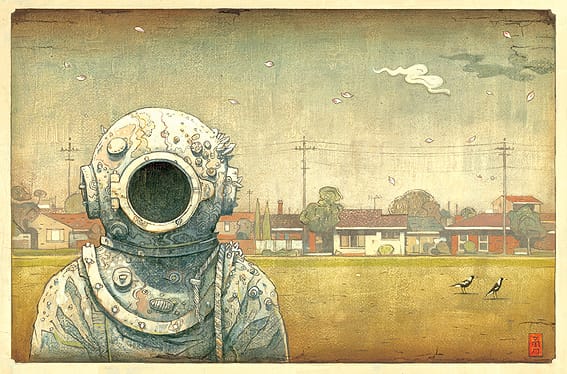Review: Tales From Outer Suburbia - Shaun Tan

Shaun Tan's collection of illustrated short stories is the second on my reading list that discovered as a child and re-read as an adult. Yet, both times I think I was reading with a writer's pair of eyes.
The first story we read (this was in year 4) was 'alert but not alarmed' about a neighbourhood that creatively adopted ballistic missile shells from military surplus into their gardens. I remember the excercise we did: thinking up ways we would decorate or own missiles and fix them up to suit our own needs. Pet houses, treehouses, pizza ovens, etc... Looking back, the story and the exercise are as brow-raising as I remembered them.
To me, the stories lie somewhere between urban legends and fairy tales, the ambivalent, fantastical midpoint of 'suburbia.' When I think of suburbia i imagine rows of identical houses, straight lines, a sky so wide it feels close to the ground, and minimal - if any - natural presence. It's a place of strange uniformity and routine, bordering on mundane. I can see exactly why Tan chose this setting for his stories.
Another one of my favourites is 'wake': a very short piece about how neighbourhood dogs united against one man to kick him while he was down, just as he'd hurt his own poor dog. As his burning house collapsed, the dogs gathered on his front lawn to urinate on all his salvaged furniture, leaving him in tears.
I didn't see them back then, but most (if not all) of the stories carry a strange sentimental message. It's almost poetic they way Tan disguised them, burying them deep beneath tales that, at face value, are more strange and entertaining, than introspective. This is the stuff of modern fairy tales and fables, after all. Unicorns and fairy kingdoms are too distant for us to take seriously. But if we see our own neighbourhoods depicted as the scene for strange happenings, of course we'll think a bit more deeply about them.
There are many stories which teach kids the consequences of lying, but not many that deal with being lied to, especially by the people which we learn are there to protect us and out comfort. Take 'The Amnesia Machine' for example, in which a machine 'beyond the comprehension of ordinary tax-payers' appears in the middle of the street to hand out free icecream. An unexplained lapse of time later, it is night, and the upcoming election has already passed: 'an unsurprising government victory'. Along the edges of the paper (a newspaper framing) are other snippets of articles suggesting all is not right in the world of free icecream. Tan implores the younger audience to take a peek at the fine print in our lives, and to question what seems too good to be true. There may be other powers at play which we have to reconsider. I think this is one of the most important lessons to teach to growing children in the digital age, as they are constantly fed information, which is overwhelmingly linked to how they view the world. It's unavoidable that among the masses of pictures they see, some of them will have an agenda. It's important they learn to spot them sooner rather than later, as not even most of adults these days can tell them apart.
Making the ordinaly unusual is one thing Tan does well, but just as magical are the ways he makes 'weird' events actually not so weird at all. Of course, people would gawk at the sight of a dugong miraculously appearing in the middle of a fighting couple's garden, stirring tensions even more. Council workers come to collect it after a while, lifting it in a harness and cradling it all the way into the rescue truck. There doesn't seem to be anything connected to this, just an isolated unexplained incident, quickly dealt with and forgotten by all but one marine biology-intrigued boy, who sneaks out of his house to lay on the grass where the beast once lay. Then, a pair of gentle hands lift him away to bed and we realise maybe perspective makes everything a lot less scary. The dugong might have just gotten lost. Haven't we all?
I'll finish up by saying that at 20 years old I enjoyed this book as much as I did when I was 9, and as much as my little sister did, who notoriously doesn't like reading (yet!) I would say there need to be more stories like Tan's in this world, and I surely hope I find some soon, but of course that runs the risk of every story becoming like this one. Maybe I was right, that suburbia is the new site of fairy tales. Maybe in 50 years traditional fairy tales, with princes and princesses and unicorns, will be the ones that seem quirky as they return from the edge of extinction.
Tales From Outer Suburbia felt ahead of its time when I was 9, but now it feels like it's right where it belongs, or maybe the world has caught up. I therefore have to give this collection 5 out of 5 stars. It has a permanent place in my heart and on my bookshelf and I hope that when I read it to my future kids, they will be growing up in a world where stories like this still feel new and exciting.